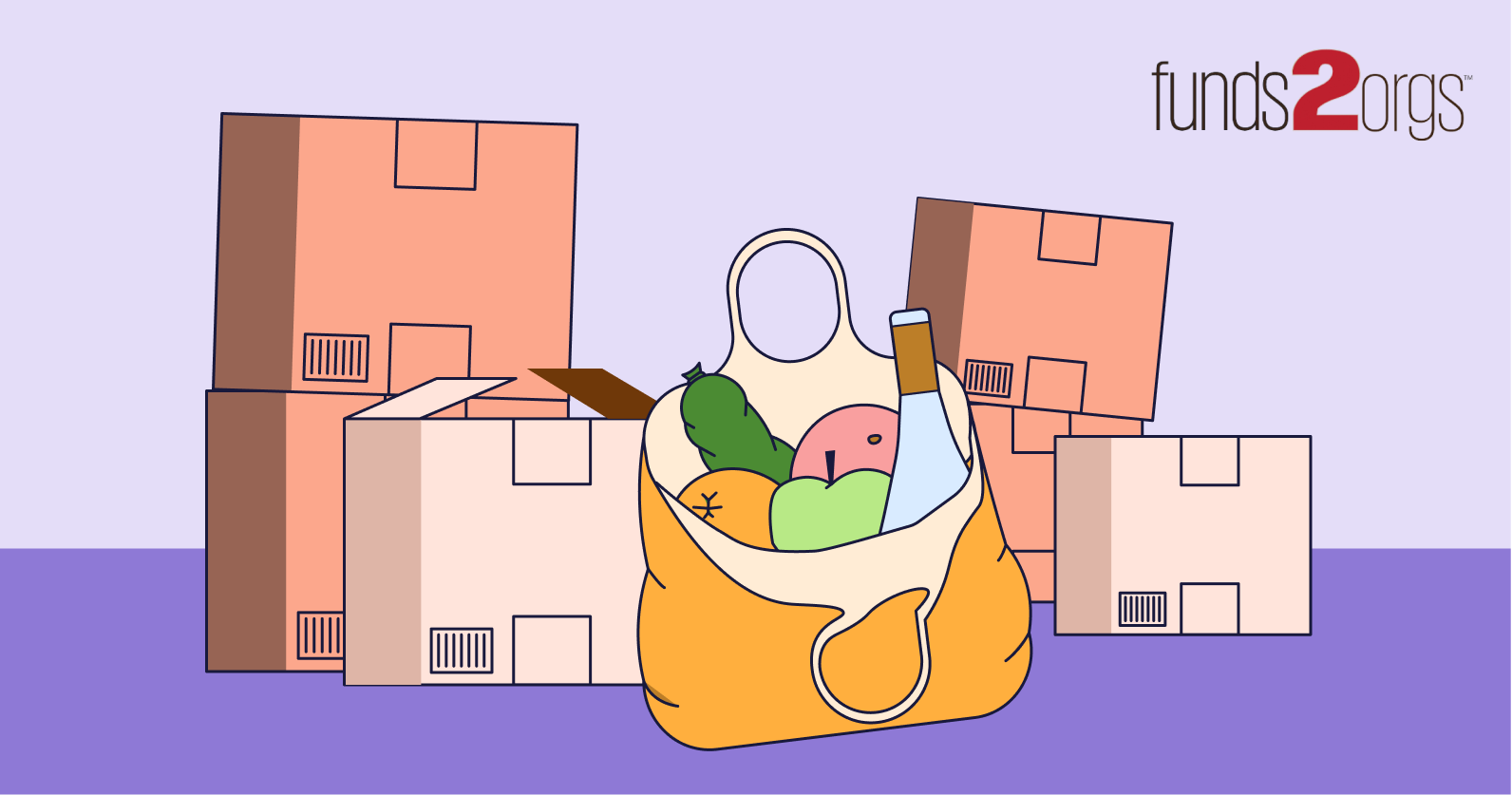
Follow these essential strategies and campaign ideas to host item donation drives that are more profitable, organised, engaging, and effective than ever before.
When most nonprofit leaders think of donations, the first things that come to mind are probably online credit card payments, mailed cheques, and other monetary gifts. However, while direct financial support is critical for your organisation, in-kind gifts are another powerful donation method you might be underutilising.
Item donation drives can be a gamechanger for your fundraising team. These fundraisers involve the collection of non-monetary donations, allowing you to engage supporters without hounding them for cash contributions. But these campaigns still enable you to give direct aid to people and communities in need.
Have we piqued your interest? If so, read on to discover the essentials to hosting a successful item donation drive. From sharing stellar donation drive ideas to explaining the right digital tools to expand your fundraiser’s reach, we’ll cover what you need to know in this guide. Specifically, we’ll take a deep dive into the following ideas:
- The Benefits of an Item Donation Drive
- 5 Tips for a Successful Donation Drive
- 3 Great Donation Drive Ideas
Perhaps you’re the leader of a bustling nonprofit hunting for donation drive strategies. Or maybe you’re part of a small faith-based charity searching for your next great church fundraiser. Whatever your mission or the size of your team, every organisation can benefit from these fundraising insights.
The Benefits of an Item Donation Drive
Before we dive any deeper, let’s take a moment to consider the advantages of hosting this kind of fundraising campaign. If you’re unsure of whether or not an item donation drive is the best course of action for your nonprofit, then consider these benefits:
- Directly address the needs of mission recipients. Donation drives allow you to target the specific, immediate needs of the communities your organisation has pledged to help. For example, you might ask for canned food for impoverished families leading up to the Thanksgiving season. Or maybe you’ll ask for gently worn, new and used shoes for small business owners in developing nations. Conduct a community needs assessment to ensure you accurately address everyone’s needs. Additionally, leverage your CRM to reach out to your supporters and survey them on what campaigns they’d be most willing and able to support.
- Appeal to supporters without asking for money. Constantly asking for money can demoralise your supporters and make them feel like little ATMs. This is what makes donation drives such a refreshing fundraiser. Moreover, many donation drives call for items many of your supporters already have at home. And that makes this a straightforward and rewarding campaign for donors and your organisation.
- Create unique fundraising opportunities to engage your community. There’s little room for creativity when you ask people to go to your online donation page or mail in a cheque. On the other hand, item donation drives are a great opportunity to shake things up with a unique fundraising campaign that calls for anything from clothes to toys to food from your supporters.
Furthermore, remember regular donors aren’t the only ones who item donation drives will engage—businesses may also find it more convenient to donate in-kind to your organisation rather than contributing money. A donation drive can set you up for future fundraising success by establishing the groundwork for corporate partnerships and sponsorships.
5 Tips for a Successful Donation Drive
If you’re eager to add an item donation drive to your fundraising calendar, consider these essential best practices for planning, marketing, and hosting a successful campaign:
- Perform preliminary research on needs, wants, and what’s available. For example, ensure your donors have or can easily acquire what you’re asking of them. Additionally, make sure the donations you’re collecting can get used to impact those receiving them significantly.
- Launch a multichannel marketing campaign. Multichannel marketing is the use of multiple platforms to promote your fundraising initiatives. This is important because it creates various points of contact to reach your target audience and spread the word about your campaign.
- Use storytelling techniques. Effective, emotional storytelling can profoundly impact your marketing and fundraising strategies, compelling donors to contribute. According to NPO Info’s statistics on charitable giving, over 42% of donors claim they were influenced to give by personal stories from a nonprofit’s beneficiaries.
- Establish an organised system for donating, pick-up, and sorting. This one is a no-brainer. Considering that your campaign depends upon physical items being collected, one of your top priorities should be making the drop-off and transportation process as seamless as possible. You might even seek the help of a dedicated fundraising service specialising in the donation drive style you’ve chosen.
- Create an engaging online experience for your drive. While donation drives are typically considered in-person initiatives, creating a robust online presence for your campaign can take things to new heights. For example, you might utilise your nonprofit website by creating an engaging event page for the campaign, including photos, videos, and other campaign content.
Of course, event management best practices vary depending on the type of donation drive you choose to organise. That said, these basic tips should lay the foundation for a more organised and engaging campaign.
3 Great Donation Drive Ideas
Now that you’re equipped with the tips and tools you need to execute an amazing donation drive, it’s time to turn our attention to specific campaigns for experimentation. In particular, we’ll run through a handful of the most popular and effective donation drive ideas for nonprofits.
Shoe Drive Fundraisers
Shoe drive fundraisers are an easy and engaging donation drive idea that involves asking your donors to bring in their gently worn, new and used shoes. These shoes will then be sold to third-party retailers and used to empower small businesses and micro-enterprises in developing countries. As a result, shoe drive fundraisers create commerce opportunities for people in developing nations.
This fundraiser is quickly becoming a fan favourite for many organisations—particularly those that deal with young children and families, such as schools. The Funds2Orgs school fundraising ideas guide explains these key benefits for shoe drive fundraising:
- Most of your supporters will already have a pair of shoes to give.
- Kids quickly outgrow shoes, making them a convenient donation item for families.
- Re-purposing and donating shoes to shoe drive fundraisers are fantastic initiatives for environmental sustainability.
- These campaigns provide a powerful example of giving people a hand-up.
For best results, contact a professional shoe drive fundraising service to coordinate your campaign and equip you with all the marketing and fundraising tools you’ll need to organise a successful fundraiser.
Seasonal Food Drives
Thanksgiving, Christmas, and other holiday and seasonal food drives are especially popular donation drives that can suit many different causes and organisations. These drives involve canned foods and other non-perishable goods to be given to families, communities, and individuals suffering from food insecurity.
As you’re organising your food drive fundraiser, keep in mind these best practices:
- Contact the communities in need who will receive your donations and survey them about the types of food items they would find most useful and valuable.
- Establish specific guidelines and suggestions regarding food donations for your donors to follow. For example, specify the importance of non-perishable goods and list the critical food donation items that community members need most.
- Recruit plenty of volunteers from local churches, schools, businesses, and the community to promote your drive and facilitate the drop-off and organisation of items.
Additionally, lean into the season to promote your food drives, such as creating marketing materials themed around particular holidays. This adds an extra layer of engagement to your campaign and reminds donors that some people do not have the same resources to fully enjoy these holy, festive, and otherwise special times of the year.
Toy Drives
As the name suggests, toy drives involve donating toys, which usually go to children, teens, and families who don’t have the budget to spare for these essentials.
As with the food drive, conduct a community needs assessment to identify items that people need. For example, the age demographics of children can greatly affect what kind of toys they need.
Be sure to share this information on your website and in your marketing materials to ensure that donors can easily identify and bring in items that donation recipients need!
Furthermore, consider hosting your toy drive during the winter holidays, when parents are already shopping for their children and may be more willing and able to pick up toys for less-fortunate families.
From their engagement potential to their ability to directly address community needs, donation drives send a powerful message to your supporters. And with these tips, tools, and the help of the right fundraising service professionals, you can hit the ground running and make the most of this impactful fundraising opportunity.




